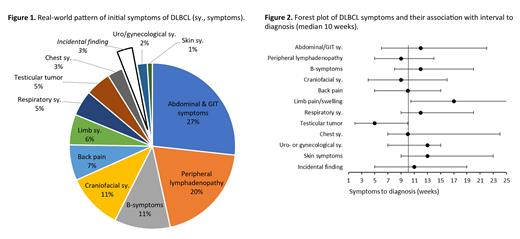Background
Symptoms of hematologic malignancies differ among the diagnoses with different proportion of patients (pts) who are diagnosed due to the incidental findings without symptoms reported by pts (e.g., 14% of MM and up to 80% of CLL cases are asymptomatic). Symptoms of lymphomas usually include peripheral lymphadenopathy, B-symptoms, gastrointestinal (GIT) and other symptoms in correlation with involved lymph node sites or affected organs. However, there is limited data on the incidence and types of initial lymphoma symptoms which lead to the diagnosis (Dg), their association with time to Dg and survival of the pts. The aim of this analysis was to describe a real-world pattern of symptoms of diffuse large B-cell lymphoma (DLBCL), which lead to the diagnostic process and ultimately to the DLBCL Dg and to correlate these findings with baseline characteristics and time to Dg.
Methods
Altogether 1576 pts with de novo DLBCL or high-grade B-cell lymphoma from Charles University, General Hospital, Prague, Czech Republic, were registered in the prospective lymphoma project (NiHiL; NCT03199066). A total of 929 pts were diagnosed between 2010-2021, including 602 (65%) pts treated by R-CHOP. Of them, 10 (2%) pts had no data on initial symptoms and were excluded from the analysis. Altogether 592 were analyzed; 574 pts (97%) had documented initial symptom or findings, which led the pts to contact the healthcare system. The remaining 18 (3%) pts had incidental findings described during examination due to the unrelated reasons which led to the diagnostic process and finally resulted to the DLBCL Dg . The type of symptoms of DLBCL and time to Dg were analyzed together with baseline characteristics and survival of the pts.
Results
The 592 pts with median age 64 years were diagnosed with advanced clinical stage in 65%, PS ECOG ≥ 2 in 26%, elevated LDH in 62%, ≥ 2 involved extranodal sites in 41%, bulky disease ≥ 7.5 cm in 41%, IPI 3-5 in 53%, and B-symptoms at the time of Dg in 42%. Median follow-up time from Dg was 7.5 years (range 0.1-13.2 years).
Among the 574 symptomatic pts, altogether 672 initial symptoms were observed. The majority - 487 (85%) pts had a solitary initial symptom of DLBCL, 73 (13%) pts had two initial symptoms, and 13 (2%) pts presented with combination of three initial symptoms. The most common combination of symptoms were B-symptoms together with abdominal/gastrointestinal (GIT) symptoms in 51 (59%) pts out of pts with ≥ 2 symptoms.
Out of the 672 initial symptoms, we have observed abdominal/GIT symptoms in 179 (27%) cases, followed by peripheral lymphadenopathy (132; 20%, most frequently head and neck in 68%), B-symptoms (76; 11%), craniofacial symptoms (71; 12%), back pain (50; 7%), limb pain/swelling (43; 6%) and respiratory symptoms (34; 5%), testicular tumor (31; 5%), chest symptoms (20; 3%), urological or gynecological (11; 2%), and skin symptoms (7; 1%; Figure 1). Although only 76 out of 592 pts (13%) presented initially with B-symptoms, additional pts developed them during the diagnostic work-up and 248 (42%) pts referred B symptoms at the time of the Dg.
Median interval from the symptom occurrence to Dg was 10 weeks (interquartile range 5-19 weeks) with shorter interval observed in pts with testicular tumor (5 weeks, P= 0.009), and prolonged in pts with limb pain/swelling (17 weeks, P= 0.003; Figure 2).
Higher IPI 3-5 was observed in 120 (74%) out of 163 pts who presented with initial B-symptoms or limb pain/swelling or and back pain ( P <0.001). Among the remaining 429 pts, higher IPI was observed in 194 (45%) pts.
Conclusion
In contrast to other hematologic malignancies, only minority (3%) of pts had incidental findings resulting in Dg of DLBCL. Out of 97% of symptomatic pts with DLBCL almost half of pts presented initially with abdominal/GIT symptoms or peripheral lymphadenopathy. Limb pain/swelling was associated with prolonged time to Dg of DLBCL, and higher IPI, while testicular tumors were associated with short time to Dg presumably due to their localization. It is important, that e.g. the proportion of pts with B symptoms increased more than 3x during diagnostic process (from initial 13% to 42% at the time of Dg). This analysis describes the unmet medical need to speed up the diagnostic process and to offer the curative therapy to the patients as soon as possible.
This work was supported by the Charles University Hematology-Oncology Cooperatio Program and grant NU21-03-00411.
Disclosures
Vodicka:Roche: Consultancy. Trněný:Takeda, BMS, Incyte, AbbVie, Amgen, F. Hoffmann-La Roche Ltd, Gilead Sciences, Janssen, MorphoSys, Novartis, Genmab, SOBI: Consultancy; Janssen, Gilead Sciences, Takeda, BMS, Amgen, AbbVie, F. Hoffmann-La Roche Ltd, MorphoSys, Novartis: Honoraria; Gilead Sciences, Takeda, BMS, F. Hoffmann-La Roche Ltd, Janssen, AbbVie: Other: Travel, Accommodation, Expenses.


This feature is available to Subscribers Only
Sign In or Create an Account Close Modal